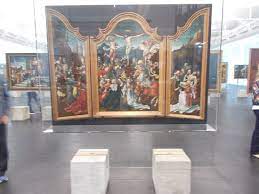Angermuseum
Angermuseum
The Angermuseum is an art museum in Erfurt that opened on June 27, 1886.
It is housed in the same building that once housed Erfurt's public weighing scales, where travelling merchants would bring their wares to be weighed in order to pay the city's customs duties. The museum faces Anger Square, which is a town common. Originally, the museum was only housed in the gallery on the first floor. It was the first municipal museum in town. The structure was built between 1706 and 1711. It was designed by the architect Johann Maximilian von Welsch. It is a Franconian-influenced baroque structure with St. Martin, the patron saint of the city, in its gable triangle.
History
Fried rich von Nerly's extensive collection of works was donated to the city of Erfurt in 1883 by his son, Fried rich Paul Nearly, with the obligation to establish a museum for the presentation of the collection. Fried rich von Nearly moved to Venice in 1835 and spent the rest of his life painting aquarelles and drawings of the city. More than 700 of the works created in Italy are part of the collection of the Anger museum. Initially, the collection focused - inspired by the works of Fried rich Nearly - on landscape painting, portraits and still lifes from the 18th to 20th centuries . Fried rich von Nerly's extensive collection of works was donated to the city of Erfurt in 1883 by his son, Fried rich Paul Nearly, with the obligation to establish a museum for the presentation of the collection. Fried rich von Nearly moved to Venice in 1835 and spent the rest of his life painting aquarelles and drawings of the city. More than 700 of the works created in Italy are part of the collection of the Anger museum. Initially, the collection focused - inspired by the works of Fried rich Nearly - on landscape painting, portraits and still lifes from the 18th to 20th centuries. It is a unique feature of the Anger museum that the citizens, rather than the princes, were involved in the museum's expansion.
Emil Nolde, Ernst Barlach, Gerhard Marcks, Max Pechstein and others and thus caused the Anger museum's collection to become known as one of the greatest of German Expressionism. The museum was at its peak in the 1920s, thanks to long-term director Herbert Kunze. The so-called "Heckelraum," which the artist Erich Heckel designed in 1922/24 with expressionist mural paintings under the motto "Stages of Life" (in German: "Lebensstufen"), is a famous example of the Expressionist collection at the time. They are the "only preserved monumental mural paintings of German Expressionism" (in German: "einzige erhaltene monumentale Wandmalereien des deutschen Expressionismus") and are still on display on the museum's ground floor.




Comments
Post a Comment